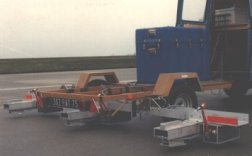Historical overview
of void detection by the pulse method
:
In 1982, the Jean PAQUET's team
at CEBTP adapted the impedance method to void detection under
pavings.
Problems under the pavement of an airport
aroused the first efforts to develop this method, the first
trials of which took place on a paving at Longjumeau, in the
suburbs of Paris.
|
1986 :
An equipment called AIDA (or TDR) was installed on a
carriage, it is meant to control large surfaces such as
the pavings of airport runways. This equipment was comprised
of a system ensuring the automatic setting of three geophones,
and of a system triggering the strikes of three hammers.
|
 |
1989
: CEBTP manufactures two specific equipments called MIMP 14,
in order to control the injection of concrete to behind the voussoirs
of the English Channel.
1994 :
A software called MIMPSTOE was created, which allowed to operate
the method with a MIMP 15 material. This acquisition software
allowed two operators to get as many as 1000 acquisitions a day.
|
1998 :
The new MIMP 16 is issued, with its specific acquisition
software, which allows one to get as many as 3000 acquisitions
a day.
The IMPR02 data processing
software, under windows 95 or 98, enables you to highlight
the results by plotting 2 - or 3 - dimensional mappings.
|
|
Frédéric Bourdet, 1998
The Material Department of CEBTP
<Back
to the characteristics of the pile integrity tester MIMP16>
|